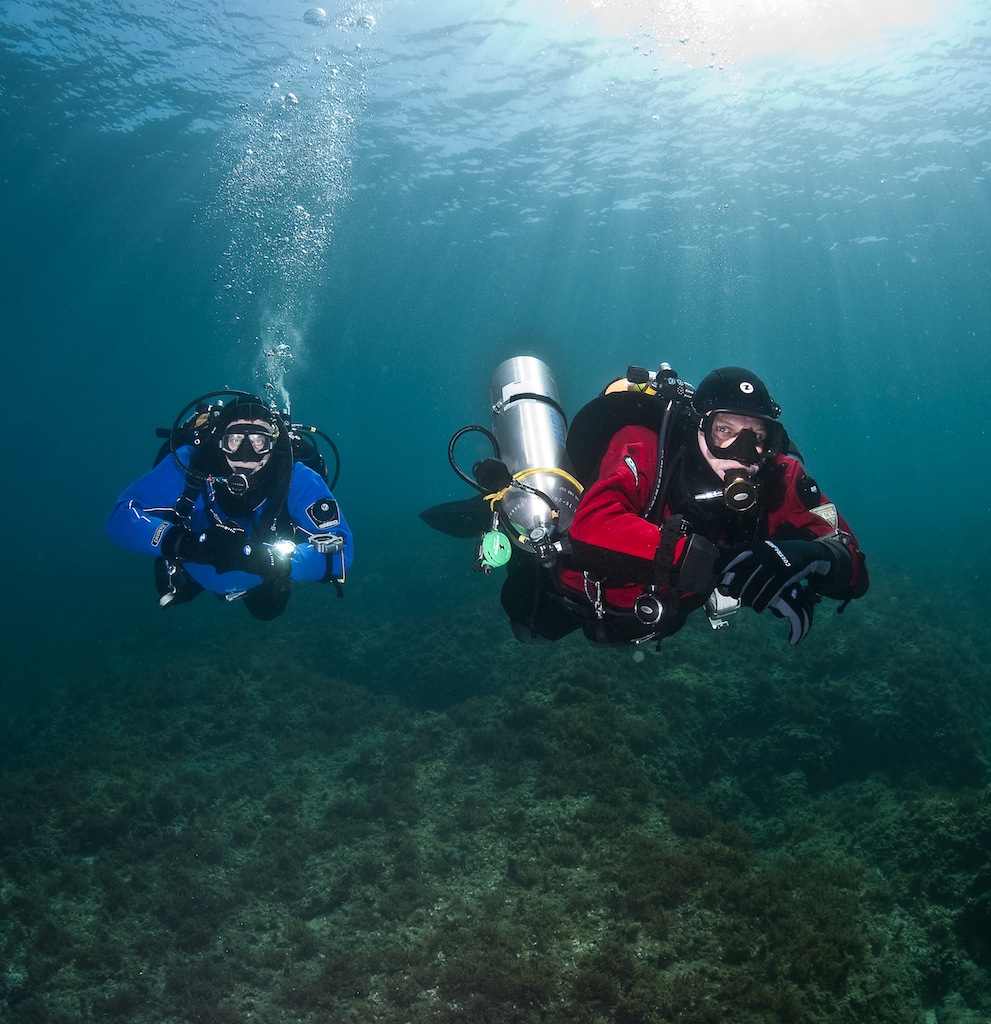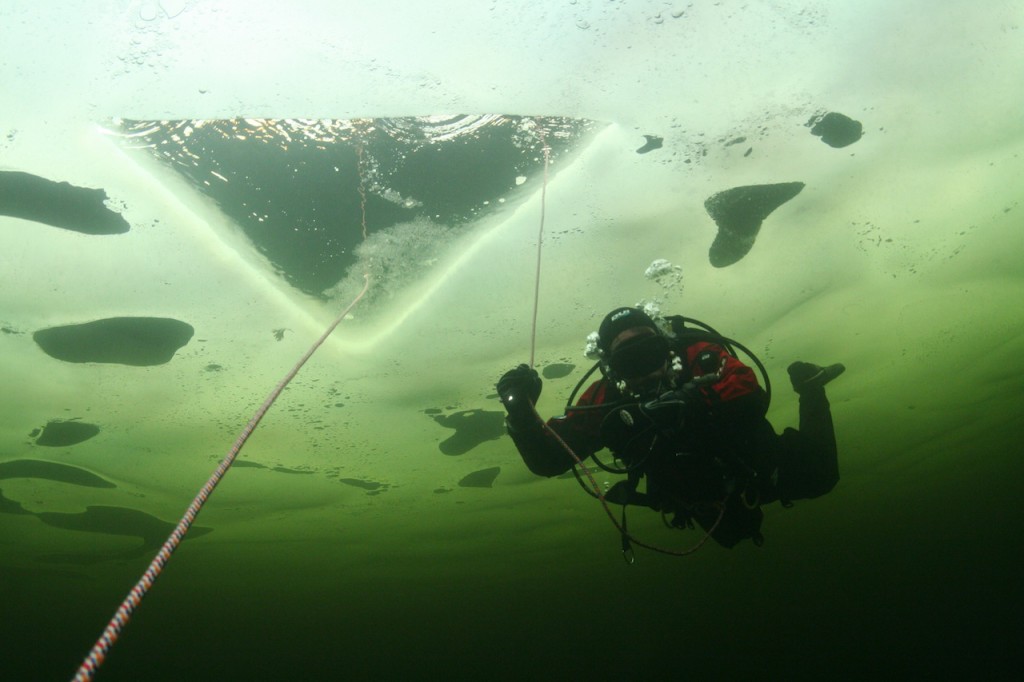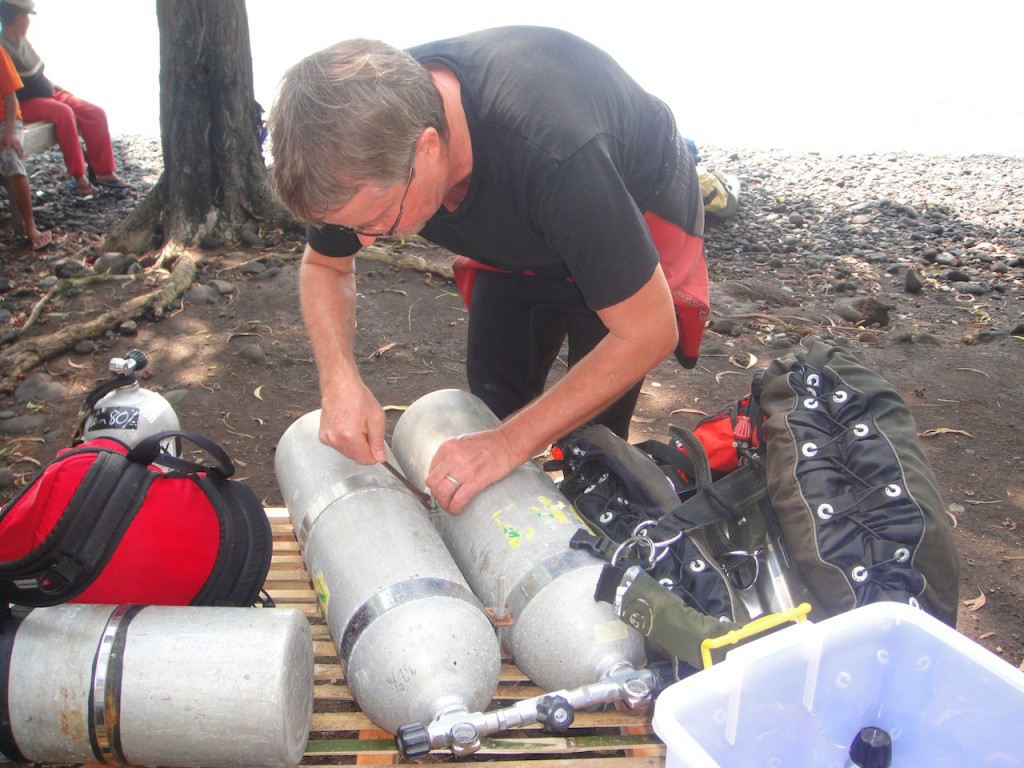News
Beware of Backsliding

Earlier this year I was invited to deliver lectures at the Oztek and ADEX shows in Sydney and Singapore respectively. One of these was on “What Makes a Good Technical Diver” and I based my talk on the Scuba Confidential chapters “To the Extreme” and “Accident Analysis.” Because my audience, particularly at Oztek, was very experienced, I found myself extrapolating on some of the themes in the book. One of the topics I touched on that received a very positive response was the danger of new generations of divers not learning from their predecessors and consequently risking accidents that were entirely avoidable. I called this tendency “backsliding” and gave a few examples to explain what I meant.
Recently I was approached by a pair of technical divers and asked for advice on an incident that had befallen them on a wreck dive. One had experienced what seemed to be have been an oxygen toxicity hit and had needed to be rescued by the other, who had blown off deco to bring him up after he had convulsed and lost his regulator at 6m (20ft.) I asked for the details of the dive and they told me the wreck was on sand at 50m (165ft), they had been diving on air and carrying deco stages of 50% and O2. They had done a little less than 30 minutes on the wreck and on ascent had switched to EAN 50 at 20m and O2 at 6m. After only a couple of minutes at 6m the diver convulsed. Both survived the dive without any residual issues apart from a crisis of confidence.
I first asked if they were sure they were really at 6m when the convulsion occurred and they assured me they were. I told them that there was no history of a diver having had an oxygen toxicity event after such a short time on a PO2 of 1.6 in very shallow water. Therefore, the most likely cause of the incident was that the diver who had convulsed had made a mistake and switched to his O2 at 20m rather than his 50%. The diver said he was sure this wasn’t the case and recounted a whole list of things he had done that made this impossible. However, he admitted he had been up late mixing gas the previous night and had only had a couple of hours sleep as he needed to wake before dawn to drive to the dive site.
The Main Point
I leave it up to you to draw your own conclusions but to my mind the debate over whether the diver had got his cylinders mixed up or not is just a side issue here. The main point is that it was completely unnecessary for these divers to have been carrying two deco gasses in the first place. Either, EAN 50 or the O2 would have done the job just fine and having one gas would have had hardly any effect on the length of time they spent on ascent. They were in calm 30-degree water in the middle of the day after all: a few minutes extra on their hang were hardly going to be a safety issue.
In the early days of technical diving, breathing the wrong gas at the wrong depth was a common problem. Some divers survived; many did not. Labelling and other conventions were established to reduce the chance of this happening. However, human error being what it is, we figured at the time that the best way to make sure you do not switch to the wrong deco cylinder at depth is only to carry one. Except of course when time and safety requirements absolutely insisted that you carry more than one deco gas; for instance if your bottom gas was a hypoxic, helium rich mix.
Back to the Age of Ignorance
This is what I mean by backsliding: a return to practices and procedures that were rejected in the early days of technical diving as being likely to lead to accidents: a step backwards in the evolutionary process either through poor training and ignorance or because divers think somehow that they are too experienced to make mistakes.
Originally, the rise of technical diving coincided with the development of the Internet. Most technical divers happened to be early adopters of the new technology (we are all just geeks deep down!) and this meant that the technical community, though widespread geographically, was closely linked online. So news travelled fast! Especially bad news! Whenever a technical diving death took place, we would pore over the details, not out of morbid curiosity but to see if there were any lessons we could learn or if anything about the accident indicated that commonly adopted procedures might be flawed. When a flaw WAS found, things moved quickly, word passed around, training standards were amended and equipment was modified. This is how our sport developed.
New Ways or Old Ways?
As time passes and new generations of divers embrace technical diving I feel there is a danger that the incidents and accidents that led us to make changes in procedures in the past will be forgotten. Unless newer divers are told why we do things the way we do, there is always the likelihood that they may experiment with new ways that are really just the old ways – old ways that were found to be inherently dangerous so were rejected and replaced by safer ways.
You may think that I am making too much of a relatively minor incident. Unfortunately, divers do not usually tell anyone about their close calls, so this story actually gives us a rare insight that, I believe, is worth dwelling on and sharing. I remember thinking at the time, “I can’t believe that with all we have learned, with all the time that’s been spent over the years trying to improve safety in technical diving, that someone can still manage to get an O2 hit on a short 50m air dive! Where have we gone wrong? How come this sort of thing is still possible?”
More Backsliding
Others examples of backsliding I have seen over the last twelve months or so include: –
- Failing to make a dive plan for a technical dive and letting your dive computer vaguely plan the dive as you go, as per regular no decompression stop sport diving!
- Carrying independent back mounted doubles, one cylinder containing your bottom gas, the other cylinder filled with your deco gas! I don’t know how anyone could think that this is a fresh idea, yet it seems to crop up in different places from time to time as a new generation gets bored of carrying stage cylinders and looks for a lazy way out, not thinking that maybe the lazy divers of previous generations have already passed this way. This is a really easy way of breathing the wrong gas at the wrong depth, as many have found to their cost. It also, of course, completely takes away your bottom gas redundancy.
- Planning overhead environment dives using the rule of thirds but with only a single cylinder and K valve – again with no protection against an air supply failure and showing a complete misunderstanding of the gas rules.
- Diving a NITROX mix trusting the dive operator’s analysis and not checking the mix yourself. This one is becoming pretty much universal, especially on liveaboards.
I recognise that whenever I preach the virtues of past practices I risk coming across as an old fart bemoaning the folly of young people of today and insisting that “back in the day” we knew better. Nothing could be further from the truth. Progress is essential: we are nowhere near a perfect world as far as diving safety is concerned. The fact that every year we lose another friend or two to this sport is ample evidence of that.
Of course, a good technical diver does not remain so entrenched in the ideas of the past that he blinds himself to the opportunities of the future. But repeating the mistakes of the past is not the way forward.
Blogs
Northern Red Sea Reefs and Wrecks Trip Report, Part 2: Wall to Wall Wrecks

Jake Davies boards Ghazala Explorer for an unforgettable Red Sea diving experience…
The second day’s diving was a day full of wreck diving at Abu Nuhas, which included the Chrisoula K, Carnatic, and Ghiannis D. The first dive of the day was onto the Chrisoula K, also known as the wreck of tiles. The 98m vessel remains largely intact where she was loaded with tiles which can be seen throughout the hold. The stern sits at 26m and the bow just below the surface. One of the highlights of the wreck is heading inside and seeing the workroom where the machinery used for cutting the tiles are perfectly intact. The bow provided some relaxing scenery as the bright sunlight highlighted the colours of the soft coral reef and the many reef fish.

Following breakfast, we then headed to the next wreck, which was the Carnatic. The Carnatic is an 89.9m sail steamer vessel that was built in Britain back in 1862. She ran aground on the reef back in 1869 and remains at 27m. At the time, she was carrying a range of items, including 40,000 sterling in gold. An impressive wreck where much of the superstructure remains, and the two large masts lay on the seafloor. The wooden ribs of the hull provide structures for lots of soft corals, and into the stern section, the light beams through, bouncing off the large shoals of glass fish that can be found using the structure as shelter from the larger predators that are found outside of the wreck.

The final wreck at Abu Nuhas was the Ghiannis D, originally called ‘Shoyo Maru,’ which was 99.5m long and built in Japan back in 1969 before becoming a Greek-registered cargo ship in 1980. The ship then ran aground on the reef on April 19th, 1983, and now sits at the bottom at a depth of 27m. Heading down the line, the stern of the ship remains in good condition compared to the rest of the hull. The highlight of the wreck, though, is heading into the stern section and down the flights of stairs to enter the engine room, which remains in good condition and is definitely worth exploring. After exploring the interior section of the ship, we then headed over to see the rest of the superstructure, where it’s particularly interesting to see the large table corals that have grown at the bow relatively quickly considering the date the ship sank. After surfacing and enjoying some afternoon snacks, we made sure everything was strapped down and secured as we would be heading north and crossing the Gulf of Suez, where the winds were still creating plenty of chop.

The next morning, it was a short hop to Ras Mohammed Nature Reserve for the next couple of days of diving. The 6am wake-up call came along with the briefing for the first site we would be diving, which was Shark & Yolanda. The low current conditions allowed us to start the dive at Anemone City, where we would drift along the steep, coral-filled wall. These dives involved drifts, as mooring in Ras Mohammed wasn’t allowed to protect the reefs. As a dive site, Shark & Yolanda is well-known and historically had a lot of sharks, but unfortunately not so many in recent years, especially not so early in the season. However, there was always a chance when looking out into the blue.

The gentle drift took us along the steep walls of the site, with plenty of anemone fish to be seen and a huge variety of corals. It wasn’t long into the dive before we were accompanied by a hawksbill turtle, who drifted with us between the two atolls before parting ways. Between the two reefs, the shallow patch with parts of coral heads surrounded by sand provided the chance to see a few blue-spotted stingrays that were mainly resting underneath the corals and are always a pleasure to see. With this being the morning dive, the early sunlight lit up the walls, providing tranquil moments. Looking out into the blue, there was very little to be seen, but a small shoal of batfish shimmering underneath the sunlight was a moment to capture as we watched them swim by as they watched us.

Towards the end of the dive, we stopped at the wreck of the Jolanda where the seafloor was scattered with toilets from the containers it was carrying. This provided a unique site to make a safety stop, which was also accompanied by a large barracuda slowly swimming by, along with a hawksbill turtle calmly swimming over the reef as the sun rays danced in the distance.
For the next dive, we headed north to the Strait of Tiran to explore the reefs situated between Tiran Island and Sharm El Sheik, which were named after the British divers who had found them. We started on Jackson before heading to Gordons Reef, where we also did the night dive. All the atolls at these sites provided stunning, bustling coral reefs close to the surface and steep walls to swim along, which always provided the opportunity to keep an eye out for some of the larger species that can be seen in the blue. Midwater around Jackson Reef was filled with red-toothed triggerfish and shoals of banner fish, which at times were so dense that you couldn’t see into the blue. Moments went by peacefully as we enjoyed the slow drift above the reef, watching these shoals swim around under the mid-afternoon sun.

The night dive at Gordon’s Reef was mainly among the stacks of corals surrounded by sand, which was great to explore under the darkness. After some time circling the corals, we came across what we were really hoping to find, and that was an octopus hunting on the reef. We spent the majority of the dive just watching it crawl among the reef, blending into its changing surroundings through changes in colour and skin texture. It’s always so fascinating and captivating to watch these incredibly intelligent animals, in awe of their ability to carry out these physical changes to perfectly blend into the reef. Before we knew it, it was time to head back to the boat to enjoy a well-deserved tasty dinner prepared by the talented chefs onboard.
Check in for the 3rd and final part of this series from Jake tomorrow!
To find out more about the Northern Red Sea reef and wrecks itineraries aboard Ghazala Explorer, or to book, contact Scuba Travel now:
Email: dive@scubatravel.com
Tel: +44 (0)1483 411590
Photos: Jake Davies / Avalon.Red
Marine Life & Conservation
Double Bubble for Basking Sharks

 The Shark Trust is excited to announce that, for two more days only, all donations, large or small, will be doubled in the Big Give Green Match Fund!
The Shark Trust is excited to announce that, for two more days only, all donations, large or small, will be doubled in the Big Give Green Match Fund!
Donate to Basking in Nature: Sighting Giants
The Shark Trust is hoping to raise £10k which will be doubled to £20k. This will go towards Basking in Nature: Sighting Giants. And they need YOUR help to reach they’re goal.
The Shark Trust’s citizen science project is to monitor and assess basking sharks through sightings; encouraging data collection, community engagement, and promoting nature accessibility. This initiative aims to enhance health and wellbeing by fostering a deeper connection with British Sharks.
Campaign Aims
- Increase citizen science reporting of Basking Sharks and other shark sightings to help inform shark and ray conservation.
- Provide educational talks about the diverse range of sharks and rays in British waters and accessible identification guides!
- Create engaging and fun information panels on how to ID the amazing sharks and rays we have on our doorstep! These can be used on coastal paths around the Southwest. With activities and information on how you can make a difference for sharks and rays!
- Promote mental wellbeing through increasing time in nature and discovering the wonders beneath the waves!
Donate, and double your impact. Click Here
-

 News3 months ago
News3 months agoHone your underwater photography skills with Alphamarine Photography at Red Sea Diving Safari in March
-

 News3 months ago
News3 months agoCapturing Critters in Lembeh Underwater Photography Workshop 2024: Event Roundup
-

 Marine Life & Conservation Blogs2 months ago
Marine Life & Conservation Blogs2 months agoCreature Feature: Swell Sharks
-

 Blogs2 months ago
Blogs2 months agoMurex Resorts: Passport to Paradise!
-

 Blogs2 months ago
Blogs2 months agoDiver Discovering Whale Skeletons Beneath Ice Judged World’s Best Underwater Photograph
-

 Gear Reviews2 months ago
Gear Reviews2 months agoGear Review: Oceanic+ Dive Housing for iPhone
-

 Marine Life & Conservation2 months ago
Marine Life & Conservation2 months agoSave the Manatee Club launches brand new webcams at Silver Springs State Park, Florida
-

 News3 months ago
News3 months agoWorld’s Best Underwater Photographers Unveil Breathtaking Images at World Shootout 2023



















